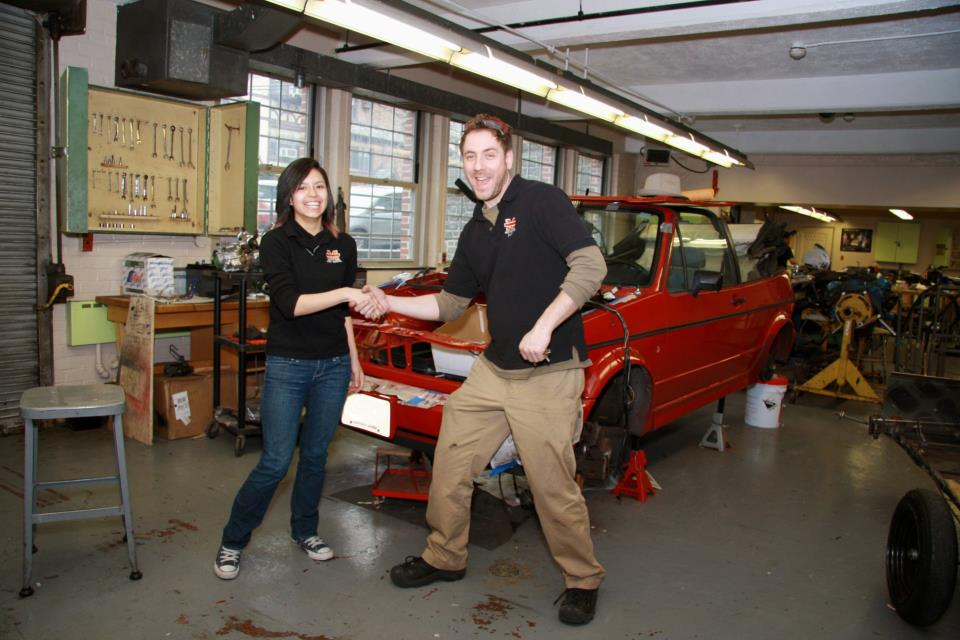Reviving auto shop classes for the EV era, one old Volkswagen at a time
; Date: September 19, 2019
Tags: Volkswagen »»»» Electric Vehicles »»»» Electric Vehicle Conversions

A high school teacher revitalized his auto shop class in West New York, N.J., by introducing an electric vehicle conversion course.
When Ron Grosinger began teaching shop class in 2005 at Memorial High School in West New York, N.J., the program was struggling to survive. In a school facing many challenges, the elective course had dwindled from six teachers to two and rarely offered any hands-on learning, Grosinger says.
As in many schools across the country, the shop program was on the path to being eliminated. Between the extra cost of running capital-intensive classes and a growing focus on college preparation, enrollment in vocational classes has dwindled from prior decades – even with a growing economic need for future mechanics.
To keep the class afloat, Grosinger knew he’d have to get creative to stay relevant. “If you’re teaching students about gasoline cars, that’s basically the equivalent of 8-track players,” says Grosinger.
So, in 2008, he approached the school’s administrators with an innovative idea: he would teach his 27 students, step-by-step, how to convert a gasoline-driven car to electric power.
“With the electric car, I wanted to prove two things,” says Grosinger. “First, [I wanted to prove] that we could convert it. Everyone was telling me at the time that it was impossible when really, we just didn’t have the option yet [on a large scale].
“Second, and most important, I wanted to prove that kids are super capable. You just have to give them a chance.”

He had recently taken an intensive, two-week EV conversion course in San Diego and believed the new program would help teach students applied science and engineering principles through automotive applications. With backing from the school, he was able to purchase his first conversion vehicle: a 1990 Volkswagen Cabriolet.
Grosinger knew it would serve as the perfect base for this specific build. “Volkswagen vehicles are known for their German engineering and affordability. They’re built with no-nonsense and the parts are readily available,” Grosinger says. “They’re also relatively lightweight, which is great for electric conversion and helps keep the battery costs down for the class. … All the money you put into them is worth it.”
Over time, the students learned how to produce the various mechanical parts in cardboard, then wood, then steel. They welded parts, tackled wiring and learned to solve problems as they arose.
“We completely gutted the car and put it all back together,” says Grosinger.

Within a year, he noticed the student makeup of the class had expanded to advanced math, science, physics and engineering students. Also, there were many more female students. “The girls in my classes are amazing engineers,” says Grosinger. “Through hands-on learning, I hope they are encouraged to maintain and broaden their interest in STEM careers.” His goal is to get the male to female ratio up to 50-50.
Every year since his first year of teaching, Grosinger has upped the ante and challenged his class to take on new projects. In the decade since the program was revamped, enrollment has dramatically increased. The department has now expanded to four teachers and the school added an after-school automotive program.
“Teachers should encourage students to explore new and more efficient ways to move a person from point A to point B, whether that system is a train with solar panels on it, a car with an electric motor in it or retrofitting an existing technology with a different energy source,” says Grosinger. “And don’t come up with the solutions for the students.”
The various automotive build projects have also led to the award of additional grant money that has helped pay for new and improved equipment. Most importantly, several of Grosinger’s students have gone on to work in the automotive field.
Grosinger attributes the popularity and growth of these courses to the promotion of STEM subjects and the infusion of high-tech equipment, like 3D printers, in the programs.
“It’s all about giving students options,” he says.


